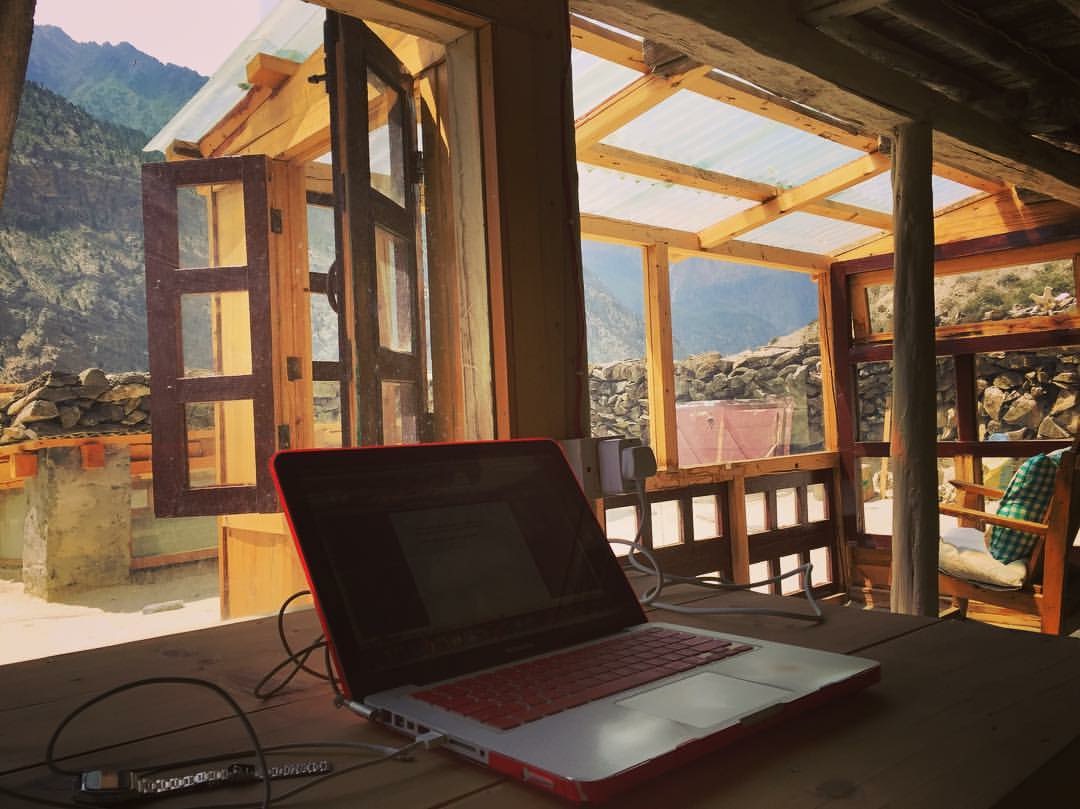Keeping No Country
A Nepal Story
By Deborah Emmanuel
11 December 2016
As the bus rolls its dusty wheels along the slopes, we bump up and down in our comfortable air-conditioned cavern. There is looseness to the passengers; everyone is in the sway of Nepalese Bus Style. No more discomfort. Only peaceful acclimatization to the jarring yet melodious horn played by the driver as he approaches each curve. Only gentle acceptance that flailing limbs is just the way it is done in Nepal. I recall the sensation of nuts and bolts flinging around my belly when I took the bus up to the mountains for the first time. How things had changed.
It has been one and a half months since I arrived in Nepal and I have been on the bus from Pokhara to Kathmandu for the last 8 hours of it, scribbling notes while I pass farmers and their families who watchfully stand still, following our bus-encased faces. Yet as long as I have been in this country and as much as I write, I am not provided with any answers from the pen. “Are these people content or frustrated with their fates?” I ask. ”Do they see the larger context within which they live, the scales with which we are measured by the people in power?” I swat the thought away and focus on the scene outside the window. One of the best ways to learn about places and people is through observation, and I was missing good learning opportunity as my mind meandered. The bus ride is a return to Kathmandu and its slovenly streets, rich with charm. Of course, I am also charmed by its exoticism. Hanging around Nepal is a stark contrast to my Singaporean high-rise administrated existence. After my time in the mountains, I am mentally preparing myself for a return to the busy city.
I have just travelled from the Mustang district where I was living for five weeks in the village of Marpha; a stone and wood hamlet on the side of Thak Khola valley, off the Annapurna trekking circuit. The village is home to about 600 villagers and The Marpha Foundation, a Nepali NGO dealing with the creative arts and education, where I spent 5 weeks as the Artist-In-Residence. During the residency I wrote "InterStates", my first one-woman show in a studio space overlooking monolithic mountains. InterStates was going to be an exploration of home and all meanings I associate with the word. For that reason, it was important to write it in a space completely alien. The Mustang district was the perfect otherworldly landscape for it, with its green peaks, fields and waterfalls contrasted against the occasional barren plain and stony road. I wanted to be objective in my art-making; paradoxical I know, but I had a place to start, in observing myself, as I made a temporary home in Marpha.
Left: Patan Durbar Square, just after sunrise. Right: My studio at the Marpha Foundation.
The more time I walked around the mountains and sipped the same air as the people did, the more I felt that it was another world. A world at peace with itself, where Tibetan Buddhists chanted mantras while committing daily tasks like herding horses and drank moonshine under the sparkle-studded sky. The more time I spent in the peaceful world, the more I became at peace with myself. I became the company I kept. At some point, it was easy to keep none. My final journey before returning to the chaos of Kathmandu was a two-day walk. I began my walk from Marpha early in the morning, alone and excited. I did not know when first starting out that it was a quest to hunt fossils, but that is what I unearthed in a sacred place called Muktinath, 3710m above sea level. Here my mountain reclusion came to an end. Only after the two-day pilgrimage. Of course, I use the word reclusion lightly even in these circumstances because in the most random, faraway bits of earth there is still the occasional hiker, farmer or friend.
Perhaps those friends don’t speak very much English; they still smile and pose for a photograph.
Marpha, Mustang District, Nepal
I arrived at Muktinath at about 3pm after spending the night in a village called Kagbeni. It could have been any part of the day. Mountains and villages have a timelessness about them, a result of comparison to the raging city, where people only rush manically against the persistence of time. Perhaps in Muktinath, the timelessness also had something to do with its ancient sacredness.
Muktinath is sacred to both Hindus and Buddhists for different reasons. For Buddhists it is an important place for Dakinis (Sky Goddesses) and the place where Guru Rinpoche (the founder of Tibetan Buddhism) meditated for some time on his way to Tibet. For the Hindus, it is also called Mukti Kshetra or "place of liberation" and is home to one of 108 Vishnu temples mentioned in the works of the Tamil poet-saints (Alvars).
This could be also because Muktinath is the birthplace of Shaligram. Shaligram are fossils which emerge out of the fossil-bed womb and fall into a stream that tumbles down to become the Gandaki River. During the long journey from Muktinath to the Gandaki river bed, the reddish-brown fossils become smooth black stones known as Shaligram. They are then collected and worshipped as aniconic representations of Vishnu and the divine.
While living in Marpha I heard of these stones again and again. They sounded fascinating. Upon arriving in Muktinath, I found some being sold in the first shop I walked into. According to tradition the stones cannot be sold, only given as a gift or exchanged for non-monetary value. Any monetary arrangement was supposed to be bad karma. The sale of Shaligram was testament to the problematic monetary system we have created and thrive upon; a system which can taint even sacred culture.
Left: Sadhus (religious ascetics) I met in Muktinath. Right: ossils collected from the bed in Muktinath.
I only had one night in Muktinath, and was easily convinced by two travellers on the balcony of Hotel Bob Marley to spend it there. Hotel Bob Marley was a homely Rastafarian reprieve from the cold, and my dreadlocked days were not so long ago. I felt very much like I belonged asleep amongst the tapestries, rolling reggae, the red, yellow and green.
That evening, as I sat in the dining room with a beer reading Heart Of Darkness surrounded by other comfortable travellers eating tasty meals, a conversation began. It was the woman sitting next to me, Holly. She turned out to be a Fulbright Scholar researching Shaligram. As the evening went deeper, we had many conversations with each other and most of the rest sitting in the dining hall. We were so comfortable talking that we didn’t care about the load shedding (when the power went out at fixed times to take loads off the grid). She invited a few of us to go on a morning expedition to collect fossils. She had a stupendous collection for her research and was excited to show us where she had gotten it. I was excited about the most Indiana Jones situation I had ever been in. We woke up at 7am to a foggy blur. It looked like it was going to rain, but air can sometimes move fast in Muktinath and by 8am, there was a patchwork quilt of both clouds and bright blue sky. A team of about eight, we walked for 20 minutes weaving around muddy rock formations and hopping across streams until we came to the raised fossil bed. After an inelegant scramble, I put my feet on the soft dark soil. I bass hummed in my chest, overwhelmed to have landed upon iron-ore-encased animals up to 175 million years old. I had never been close to anything that ancient. These fossils had been friends to the dinosaurs, and they were now in my own millennial hands. Surreal stuff. By the end of the two-hour hangout on top of that fossil bed, I had collected 12 beautiful fossils in my backpack.
My next stop was Australia, where I intended to give at least a couple to my free-spirited-yet-scientific crew of friends...but not before they served one other purpose.
We got back to Hotel Bob Marley, I packed my bag and looked for a jeep driver to take me back to Marpha. There, I performed "InterStates" for some of the villagers using the fossils for the first time. I began the show with putting the fossils in a circular formation, like fossil fairy ring. Then I used more fossils to symbolise Singapore, my apartment and other elements of our world.
Another reason I had chosen to write about "home" in a place like Nepal was that the country had always drawn me to discover it. During the show, I used the fossils to represent a merging of all my homes - the earth, the animals and people who inhabit it, the cultures and borderless love which I had found within myself and Nepal.
In that way, my journey comes full circle. I again find myself on the bus in which this story started, comfortably bobbing up and down on a dusty Nepalese road with a backpack full of old fossils which I don’t need to carry.
They are now a part of my home.
Photo: Performing "InterStates" to an audience in Kathmandu, with a fossil world at my feet.
All photos by Deborah Emmanuel. http://deborahemmanuel.com/





